Red Cross Blames Climate Disasters for Blood Shortage

The blood supply in the United States has dropped to critically low levels, in part because of “back-to-back months of worsening climate-related disasters,” the American Red Cross said on Monday.
The national supply has fallen nearly 25 percent since early August, and Hurricane Idalia, which made landfall in Florida late last month, caused more than 700 units of blood and platelets to go uncollected, the organization said in a news release.
The distribution of blood was outpacing the number of donations, officials said, adding that 2,500 hospitals and transfusion centers rely on the Red Cross to collect 12,500 blood donations each day.
Donor turnout last month also dropped after one of the busiest travel seasons on record, along with back-to-school activities, contributing to a shortfall of 30,000 donations.
“For so many patients living with urgent medical care needs, crises don’t stop with natural disasters,” Dr. Pampee Young, chief medical officer for the American Red Cross, said in a statement. “In fact, in some instances the stress of a disaster can lead to a medical crisis for some individuals battling sickle cell disease.”
Dr. Young said that the need for blood was constant, and that someone in the United States needs blood every two seconds.
With the Atlantic hurricane season now peaking, Red Cross officials have turned a watchful eye to the coastlines and were monitoring the track of Hurricane Lee, although it was unclear whether the storm would pose a threat to the United States. If it does, the Red Cross said the storm could further disrupt the collection of blood products.
The demand for blood is not new, and the Red Cross has issued warnings in the past. In the summer of 2021, the Red Cross announced a blood shortage, causing some hospitals to slow the pace of elective surgeries until blood levels had rebounded. Another shortage was announced the year before, when donation centers had to close because of the coronavirus pandemic.








